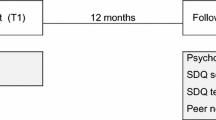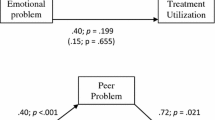Abstract
Social competence, peer status, and clinical symptomatology were evaluated in 54 child psychiatric inpatients. Aims were (a) to evaluate whether social competence deficits and peer rejection within an inpatient setting were associated with particular childhood disorders, and (b) to identify predictors of peer status in emerging groups of child inpatients. Results indicated that children with externalizing disorders (conduct or attention deficit disorders) and children with concurrent depressive and externalizing disorders were the most rejected, least liked, and least socially competent children. Depressed children without externalizing disorders had the highest scores on the social status and competence measures. Predictors of peer rejection and acceptance in the hospital differed, with measures of symptomatology predicting peer rejection, and measures of social and intellectual competence predicting peer acceptance. Implications of the results for understanding the role of peer adjustment and social competence in developmental psychopathology were discussed.
Similar content being viewed by others
References
Achenbach, T. M., Edelbrock, C. (1983).Manual for the Child Behavior Checklist and Revised Child Behavior Checklist. Burlington, Vermont: University of Vermont.
Asarnow, J. R. (1983). Children with peer adjustment problems: Sequential and non-sequential analyses of school behaviors.Journal of Consulting and Clinical Psychology, 51, 709–717.
Asarnow, J. R., & Carlson, G. A. (1985). The Depression Self-Rating Scale: Utility with child psychiatric inpatients.Journal of Consulting and Clinical Psychology, 53, 491–499.
Asarnow, J. R., Carlson, G. A., & Guthrie, D. (1987). Coping strategies, self-perceptions, hopelessness, and perceived family environments in depressed and suicidal children.Journal of Consulting and Clinical Psychology, 55, 361–366.
Blechman, E. A., McEnroe, M. J., Carella, E. T., & Audette, D. P. (1986). Childhood competence and depression.Journal of Abnormal Psychology, 95, 223–227.
Coie, J. D., & Kupersmidt, J. B. (1983). A behavioral analysis of emerging social status in boys' groups.Child Development, 54, 1400–1416.
Dodge, K. A. (1983). Behavioral antecedents of peer social status.Child Development, 54, 1386–1399.
Hartup, W. W. (1983). Peer relations. In E. M. Hetherington (Ed.),Handbook of child psychology. (Vol. 4, pp. 103–196). New York: Wiley.
Hauser, R. M., & Featherman, D. L. (1977).The process of stratification: Trends and analysis. New York: Academic Press.
Hymel, S., & Asher, S. (1977 March).Assessment and training of isolated children's social skills. Paper presented at the biennial meeting of the Society for Research in Child Development, New Orleans.
Jones, F. H. (1974). A 4-year follow-up of vulnerable adolescents: The prediction of outcomes in early adulthood from measures of social competence, coping style, and overall level of psychopathology.Journal of Nervous and Mental Disease, 159, 20–39.
Kazdin, A. E. (1987). Conduct disorder in childhood and adolescence. Beverly Hills, Sage.
Kazdin, A. E., Colbus, D., & Rodgers, A. (1986). Assessment of depression and diagnosis of depressive disorder among psychiatrically disturbed children.Journal of Abnormal Child Psychology, 14, 499–516.
Kazdin, A. E., Esveldt-Dawson, K., Sherick, R. B., & Colbus, D. (1985). Assessment of overt behavior and childhood depression among psychiatrically disturbed children.Journal of Consulting and Clinical Psychology, 53, 201–210.
Keller, M. (1986, October).The course of major depressive disorder in children. Paper presented at the meeting of the Depression Risk Consortium, St. Louis, Missouri.
King, C. & Young, R. D. (1982). Attentional deficits with and without hyperactivity: Teacher and peer perceptions.Journal of Abnormal Child Psychology, 10, 483–496.
Ledingham, J. E., & Schwartzman, A. E. (1984). A 3-year follow-up of aggressive and withdrawn behavior in childhood: Preliminary findings.Journal of Abnormal Child Psychology, 12, 157–168.
Lefkowitz, M. M., & Tesiny, E. P. (1980). Assessment of childhood depression.Journal of Consulting and Clinical Psychology, 48, 43–50.
Lewinsohn, P. M., and Hoberman, H. M. (1982). Depression. In A. Bellack, M. Hersen, & A. Kazdin (Ed.),International handbook of behavior modification and therapy (pp. 397–428). New York; Plenum.
Morris, H. H., Jr., Escoll, P. J., & Wexler, R. (1956). Aggressive behavior disorders of childhood: A follow-up study.American Journal of Psychiatry, 112, 991–997.
Peterson, L., Mullins, L., & Ridley-Johnson, R. (1985). Childhood depression: Peer reactions to depression and life stress.Journal of Abnormal Child Psychology, 13, 597–610.
Rubin, K. H. (1985). Socially withdrawn children: An “at risk” population? In B. Schneider, K. H. Rubin, & J. Ledingham (Eds.),Children's peer relations: Issues in assessment and intervention (pp. 125–140). New York: Springer-Verlag.
Satterfield, J. H., Hoppe, C. M., & Schell, J. M. (1982). A prospective study of delinquency in 110 adolescent boys with attention deficit disorder and 88 normal adolescent boys.American Journal of Psychiatry, 139, 795–798.
Strauss, C. C. Forehand, R., Smith, K., & Frame, C. L. (1986). The association between social withdrawal and internalizing problems of children.Journal of Abnormal Child Psychology, 14, 525–536.
Strauss, C. C. Lahey, B. B., Frick, P., Frame, C. L., & Hynd, G. W. (1988). Peer social status of children with anxiety disorders.Journal of Consulting and Clinical Psychology, 56, 137–141.
Vosk, B., Forehand, R., Parker, J. B., & Richard, K. (1982). A multimethod comparison of popular and unpopular children.Developmental Psychology, 18, 571–575.
Whalen, C. K., & Henker, B. (1985). The social worlds of hyperactive children.Clinical Psychology Review, 5, 477–478.
Author information
Authors and Affiliations
Additional information
This research was supported in part by Biomedical Research Support Grant RR756 awarded to the author. The author wishes to thank Donald Guthrie and Sondra Purdue for their statistical consultation, Gwen Gordon for her computer assistance, and Joan Trumbull for her assistance with data collection.
Rights and permissions
About this article
Cite this article
Asarnow, J.R. Peer status and social competence in child psychiatric inpatients: A comparison of children with depressive, externalizing, and concurrent depressive and externalizing disorders. J Abnorm Child Psychol 16, 151–162 (1988). https://doi.org/10.1007/BF00913591
Revised:
Issue Date:
DOI: https://doi.org/10.1007/BF00913591




